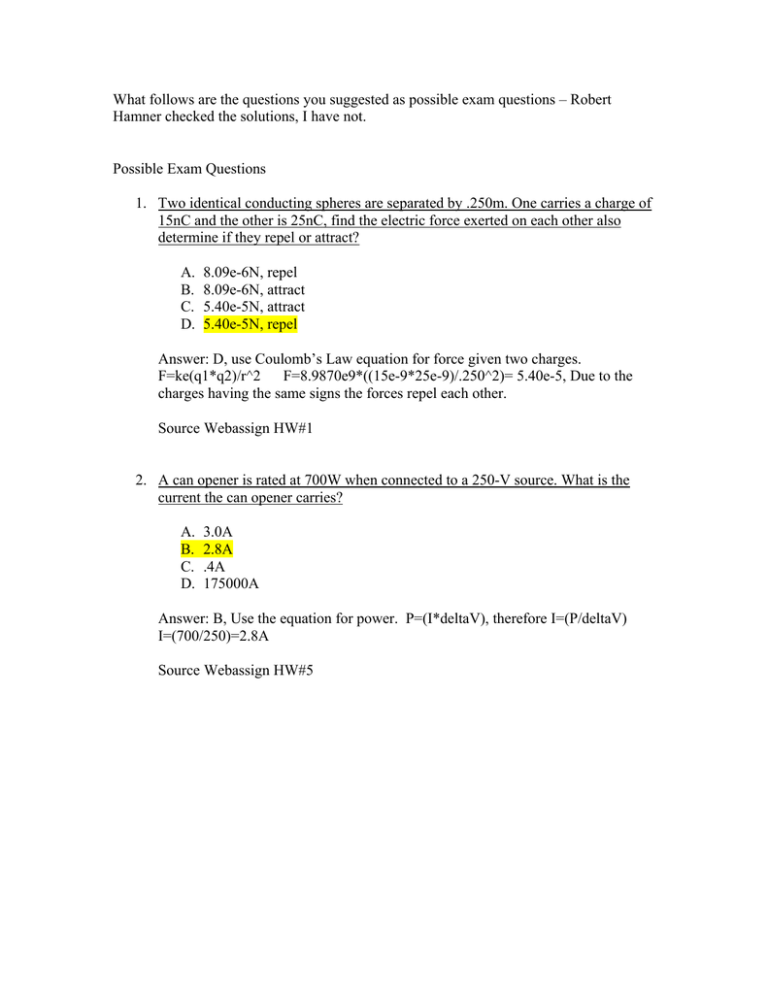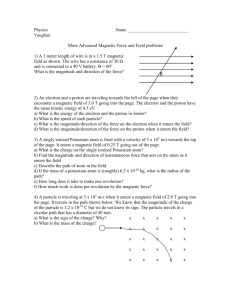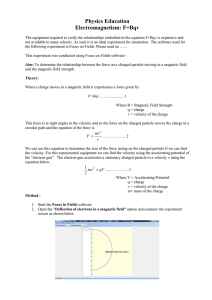Your exam questions
advertisement

What follows are the questions you suggested as possible exam questions – Robert Hamner checked the solutions, I have not. Possible Exam Questions 1. Two identical conducting spheres are separated by .250m. One carries a charge of 15nC and the other is 25nC, find the electric force exerted on each other also determine if they repel or attract? A. B. C. D. 8.09e-6N, repel 8.09e-6N, attract 5.40e-5N, attract 5.40e-5N, repel Answer: D, use Coulomb’s Law equation for force given two charges. F=ke(q1*q2)/r^2 F=8.9870e9*((15e-9*25e-9)/.250^2)= 5.40e-5, Due to the charges having the same signs the forces repel each other. Source Webassign HW#1 2. A can opener is rated at 700W when connected to a 250-V source. What is the current the can opener carries? A. B. C. D. 3.0A 2.8A .4A 175000A Answer: B, Use the equation for power. P=(I*deltaV), therefore I=(P/deltaV) I=(700/250)=2.8A Source Webassign HW#5 1. What is the equivalent Capacitance of the following circuit? Solution: → Equivalent Capacitance = 38/9 F 2. Which magnetic pole is presently located geographically north? Solution: The South Pole. You can see this because opposite poles attract, so if you have a compass and the needle on the compass points north, you know a south pole must be located above where it is pointing, i.e. geographically north. An electron moves with a velocity of = 12 + 5 + 13 m/s in a magnetic field of = 3 + 4 + 5 T. What is the magnitude of the magnetic force the electron experiences as it moves through the field? A. 47.5 N B. 7.61 x 10^(-18) N C. 6.88 x 10^(-19) N D. 89.5 N E. None of the above Solution: The magnetic force is equal to FB = q x . The charge, q, of an electron is -1.602 x 10^(-19) C. First you multiply the velocity vector by the charge of the electron: q = 12(-1.602e-19) + 5(-1.602e-19) + 13(-1.602e-19) q = (-1.9224e-18) + (-8.01e-19) + (-2.0826e-18) Then you do the cross product of qV x B: FB = q x = (-1.9224e-18) 3 (-8.01e-19) 4 (-2.0826e-18) 5 FB = (4.3254e-18) + (3.3642e-18) + (-5.2866e-18) Now for the magnitude of FB: |FB| = √((4.3254e-18)2 + (3.3642e-18)2 + (-5.2866e-18)2) |FB| = 7.61 x 10^(-18) N Thus the answer is A. Source: Modified question from Webassign HW #6 Question #3: “A proton moves with a velocity of = (2 - 6 + ) m/s in a region in which the magnetic field is = ( + 2 - 3 ) T. What is the magnitude of the magnetic force this charge experiences?” Problem 1 Making an electric circuit with a capacitor and an inductor in series with a light bulb will do which of the following? A. Blink B. Increase Intensity C. Decrease Intensity D. Stay the Same Problem 2 A solid conducting sphere with a charge of +2q is surrounded by a hollow conducting sphere with a charge of -4q what is the charge on the outside of the hollow sphere? -4q ? +2q Solution: Since the small sphere is a conductor all the charge is located on the surface, and the inner surface of the shell must balance with the surface of the smaller sphere. So the charge left on the outer surface is -2q because the total charge on the shell is -4q Quantitative What is the reactance xc of an AC Circuit with frequency 400 Hz and Capacitor 20mF? A .212 B .0375 C .0199 ***Correct*** D .125 E0 Solution: xc=1/(wC) w=2(pi)f xc=1/(2*pi*f*C) xc=1/(2=pi*400*.02) Qualitative The maximum current in an AC circuit does not depend on the period for which of the following choices A Resistor ***Correct*** B Capacitor C Inductor D A and B E B and C Solution: For resistors we have Imax=(deltaVmax)/(Resistance) This leads us to answers A or D. For capacitors we have Imax=(deltaVmax)(angular speed)(Capacitance) and angular speed = 2*pi/(Period T), so B,D and E are incorrect. For Inductors we have Imax=(deltaVmax)/((angular speed)*(inductance)) and angular speed =2*pi/(Period T), so C and E are eliminated. PH 106 Suggested Final Exam Problems Qualitative Question: Let q1 and q2 be two positive point charges. Let V be the potential at the position of q2 due to q1. Which of the following will not cause an increase in V? A. B. C. D. E. Increasing the charge on q1. Increasing the charge on q2. Moving q1 closer to q2. Neither A, B, nor C will cause an increase in V. All of A, B, and C will cause an increase in V. Solution: B. The potential created by a point charge q a distance r away is: V = ke In this problem, the source charge is q1, so increasing its charge will increase the potential. And moving q1 closer to q2 will lower r and increase V. So answers A and C are incorrect. But since q2 is the test charge and not the source, altering it has no effect on the potential due to q1. Therefore, B is the correct answer. Source: This idea for this problem came from Quick Quiz 25.3i: “Take q1 to be a negative source charge and q2 to be the test charge. If q2 is initially positive and is changed to a charge of the same magnitude but negative, what happens to the potential at the position of q2 due to q1?” Quantitative Question: Let the time-varying magnetic flux through a single-loop coil be represented by the following equation, where t is in seconds: ФB = 8cos(3t) [T m2] What is the magnitude of the induced emf in the coil at time t = 5 sec? A. 18.2 V B. 6.2 V C. 8 V D. 5.20 V Solution: B. The equation for this problem is Faraday’s law of induction: ε = -N This problem asks for the magnitude, the coil has one loop, and the equation for the flux is given, so the emf equation becomes: |ε| = | -1 8cos(3t)] | = | -[-24sin(3t)] | = | 24sin(3t) | At time t = 5 sec, the evaluated emf is: |ε| = | 24sin(3 5) | = 6.2 V So B is correct. 1. An electric heater is rated at 1500 W, a toaster at 500 W, and an electric grill at 1000 W. The three appliances are connected to a common 120 V household circuit. (a) How much current does each draw? Heater: I = (1500/120) = 12.5 A Toaster: I = (500/120) = 4.17 A Grill: I = (1000/120) = 8.33 A (b) Is a circuit with a 26 A circuit breaker sufficient in this situation? 12.5 A + 4.17 A + 8.33 A <= 26 A 25 A <= 26 A Yes, a 26 Amp circuit breaker would be sufficient because the total current draw is equivalent to 25 Amps 2. Assume that you have a battery of emf E and three identical lightbulbs, each having constant resistance R. (a) What is the total power from the battery if the bulbs are connected in series? I = E / 3R R(eq) = 3R P = EI = (E^2) / 3R (b) What is the total power from the battery if the bulbs are connected in parallel? R(eq) = 1 / (1/R) + (1/R) + (1/R) I = 3E / R P = EI = 3(E^2) / R (c) For which connection will the bulbs sine the brightest? The parallel connection supplies 9 times more power Someone fires a positively charged particle from the exact location of the Earth's magnetic north pole (currently in Canada), in the direction of the United States (to the south). In what direction is the force that the Earth's magnetic field exerts on the particle? A. North B. West C. directly into the atmosphere D. into the Earth Answer: B. Solution: By use of the right hand rule, if we imagine looking at the firing of the proton from above, the Earth's magnetic field would be coming out the page, and the velocity of the proton would be directed down. This would make the force on the proton directed left, or to the west. What is the angular velocity of a .05 kg particle with a charge of 1 C moving in a magnetic field of 1 T? mv 2 qB v F = qvB = ⇒ = = ω ⇒ ω = 20 r m r Rank the current across each resistor. A. B. C. D. E. R1 > R2 > R3 > R4 R5 R5 > R4 > R3 > R2 > R1 R1 = R2 = R3 > R4 = R5 R1 = R5 = R4 > R2 = R3 R1 = R5 = R4 < R2 = R3 In the single: V/R = I In the series: V/(R + R) = I In the Parallel: V/ (1/R + 1/ R) = I but the I splits in half for each resistor so I of one = I of the single resistor. D. R1 = R5 = R4 > R2 = R3 Find the equivalent capacitance A. B. C. D. 9/15 F 15/9 F 23 F 13/5 F The formula for Capacitors in Parallel is ( C1 + C2 + C3…. = C EQ) So 5 + 5 + 5 = 15 The formula for Capacitors in Series is (1/C EQ = 1/C1 + 1/C2 + 1/C3…) Therefore 1/3 + 1/15 + 1/5 = 9/15 So the equivalent capacitance is 15/9 F. B. 15/9 F Question: A rectangular box encloses charged particles. In which of the following situations would the net electric flux through the box have the greatest magnitude? A. B. C. D. E. The box holds a single proton. The box holds one proton and one electron. The box holds three protons and two electrons. The box holds three protons. All of the above situations give the same net electric flux. Solution: The net electric flux through any closed surface is calculated by using Gauss’s Law. Ф_E = q_in\є_0 Because є_0 is a constant, the electric flux will change as the net enclosed charge changes. The net charge is the sum of the charges within the box. If the box holds only one proton, the net charge is e. If the box holds one proton and one electron, you must add the charges together. e + (-e) = 0 The net charge is 0. Because these two answers are different, E is an incorrect answer. If the box holds three protons and two electrons, the net charge is: e+e+e-e-e=e If the box holds three protons, the net charge is: e + e + e = 3e The situation with the greatest net charge will lead to the greatest electric flux. Therefore, the answer is D. Question: A particle carrying a charge of 4C moves through a velocity selector. The electric field applied on the charge is 20V\m . The particle passes through the velocity selector in a straight line with a speed of 2m\s. A second particle with a charge of 12C passes through the same velocity selector; however, the electric field is now 40V\m. The magnetic field remains the same. How fast much the second particle move in order to go through the velocity selector in a straight line? A. B. C. D. E. 6m\s 2m\s 4m\s 1m\s 10m\s Solution: If the first particle passed through the velocity selector in a straight line, the electric force and the magnetic force exerted on the particle must have equal magnitudes. F_E = F_B qE = qvB In order for the second particle to pass through the velocity selector in a straight line, it must be under the same conditions. qE = qvB Because the charge is calculated on both sides of the equation, it is does not affect the needed speed. E = vB V = E\B To find the speed of the second particle, you must find the magnitude of the magnetic field, which remains the same in both situations. For the first particle: B = E\V = 20\2 = 10 T Use this same magnetic field for the second particle: V = E\B = 40\10 = 4m\s The second particle must have a speed of 4m\s. The correct answer is C. Source: This is a modified question from the Mass Spectrometer lab. The original question was: If an electron moves with v = 106 m/s and the magnetic field B = 0.1T : Calculate the strength of the electric field required to keep the electron on a straight path. Quantitative Question Question: Calculate the radius of the circular orbit given that the magnitude of the magnetic field B = 0.25 T and let the charge be a proton moving with a speed of 1.6 x 106 m/s. Solution: The radius is given by the formula r = (m*v) / (|q|*B). So the charge which is q of the proton is 1.60 x 10-19 C and the mass of the proton is 2 x 10-27 kg. So r = (2 x 10-27 kg) * (1.6 x 106 m/s) / (1.60 x 10-19 C) * (0.25 T) which solves out to be the radius is 0.08 meters. Source: Modified question from WebAssign, the original question was: “Calculate the radius of the circular orbit for the parameters specified below. Part (a) uses parameter values that can be set using the animation sliders, and you can use the animation to verify your calculations. Part (b) uses parameter values outside the range of the animation. (a) Let the magnitude of the magnetic field B = 0.7 T and let the charge be an electron moving with a speed of 2.10 106 m/s. (b) Let the magnitude of the magnetic field B = 1.1 T and let the charge be an electron moving with a speed of 8.50 106 m/s.” Qualitative Question Question: You are given a battery of emf and five identical light bulbs, each having a constant resistance R. Which bulb will be the dimmest when the circuit is turned on? A) Series B) Parallel Solution: The equivalent resistance in series for the circuit is Req = 5R. This resistance also then means that the current through the circuit is I = (emf) / 5R. Using these two answers the power calculated for the series circuit is P = (emf2) / 5R. The equivalent resistance in series for the circuit is Req = R / 5. This resistance also then means that the current through the circuit is I = (5 * emf) / R. Using these two answers the power calculated for the series circuit is P = (5 * emf2) / R. Thus the correct answer is A) Series because it has 5 times less power. Source: Modified question from WebAssign, the original question was: “Assume that you have a battery of emf and three identical light bulbs, each having constant resistance R. (a) For which connection will the bulbs shine the brightest?” Question: A uniform electric field points in the direction of the y-axis. If an electron which was originally at the point (3cm, 1cm) is moved to the point (5cm, 1cm), what is the change in potential energy? A. increases B. decreases C. no change D. not enough information to tell Solution: The field points up (the direction of the y-axis). There is no change in the electron’s ycoordinate, so it is moving perpendicularly to the electric field. Thus, the change in potential energy is zero and C is the correct answer. Question: A three-way light is installed in a two filaments are is the equivalent entire light bulb are closed? Solution: bulb, wired as shown, 120V socket. If the 100W and 75W, what resistance of the when both switches



